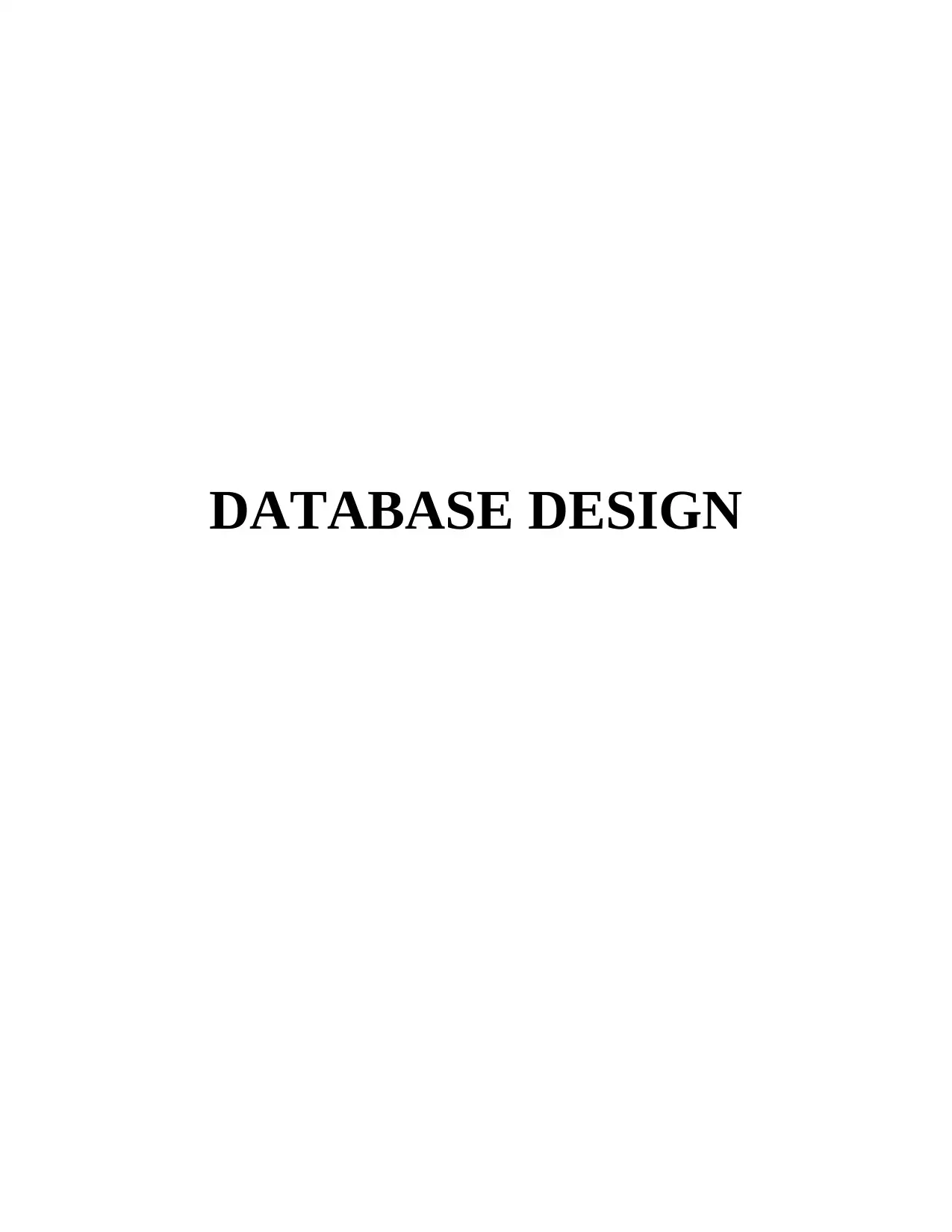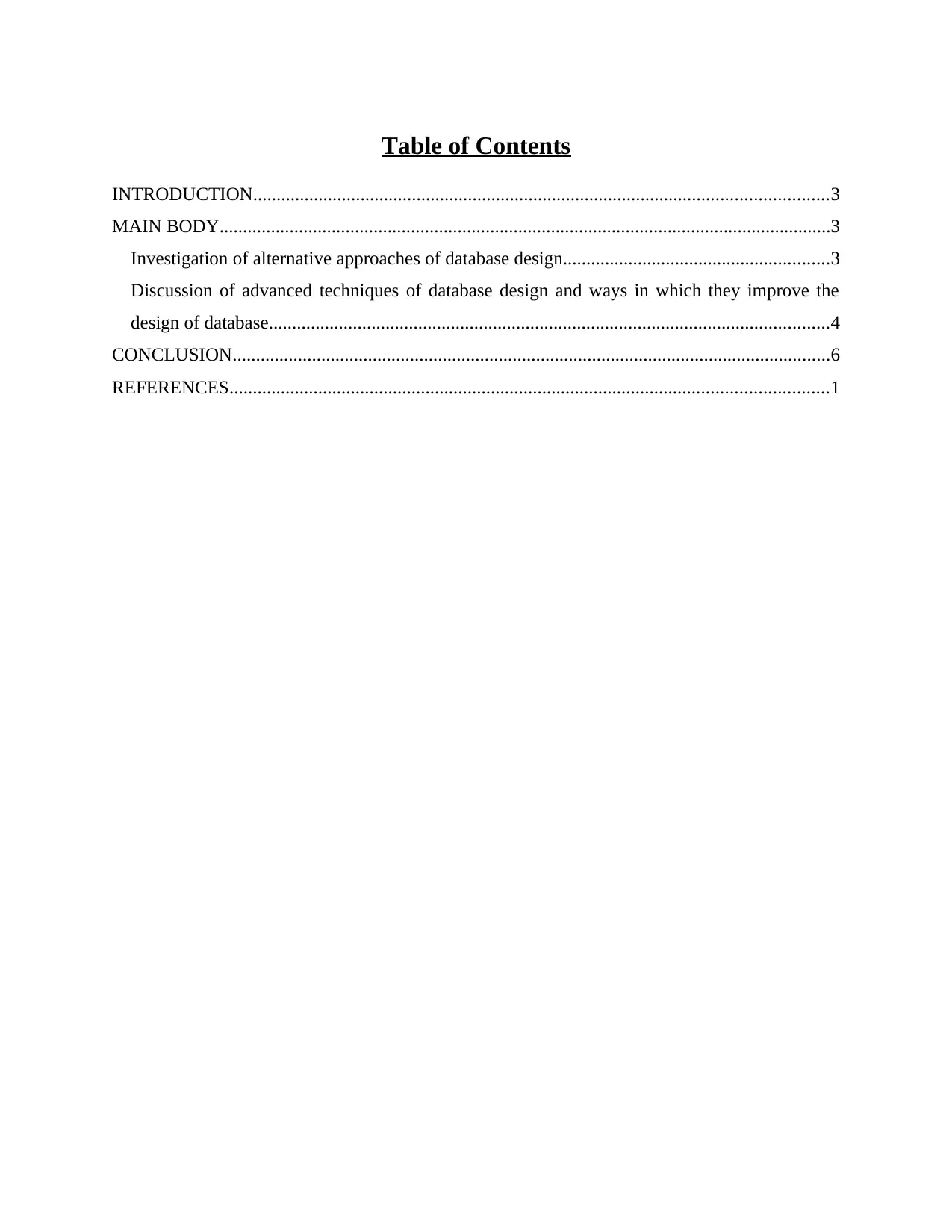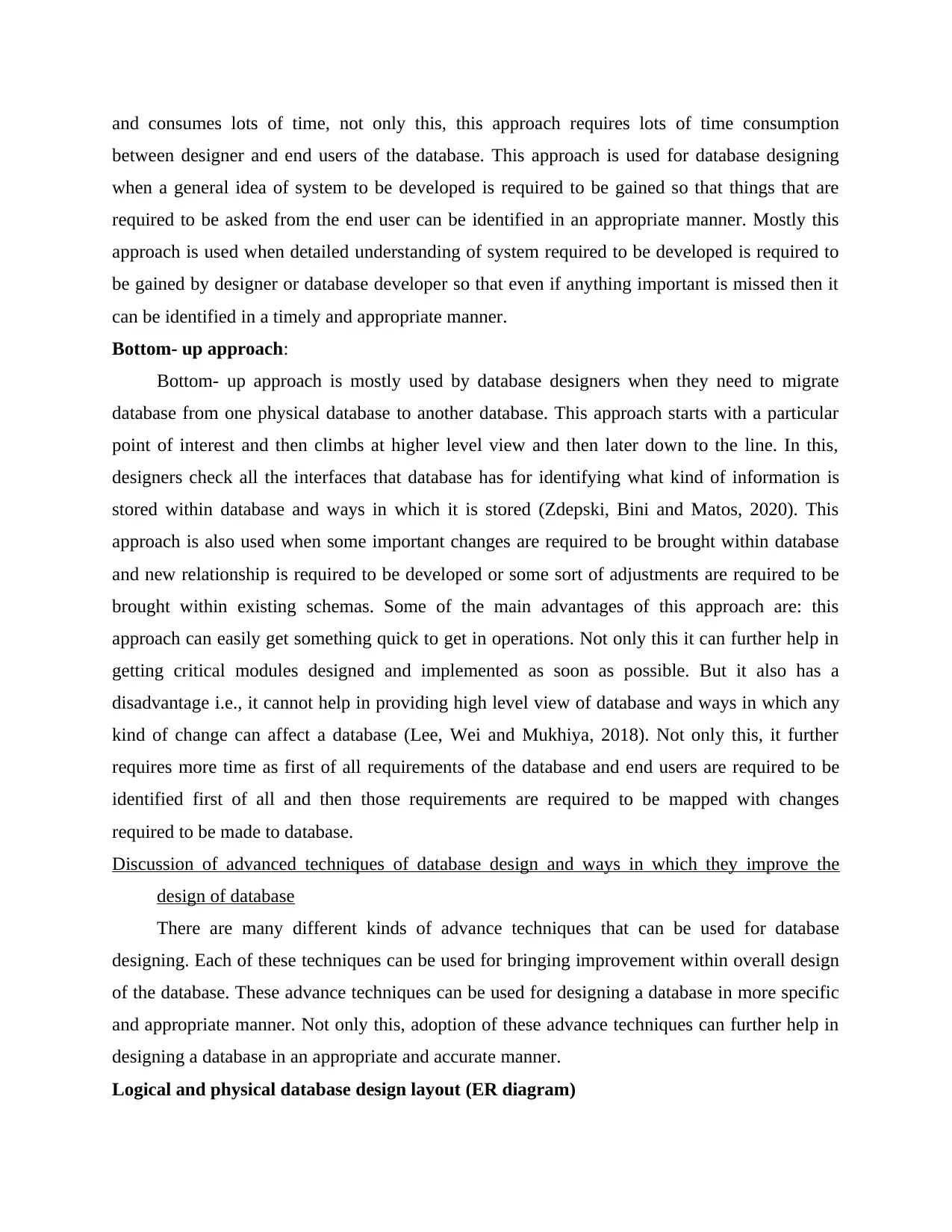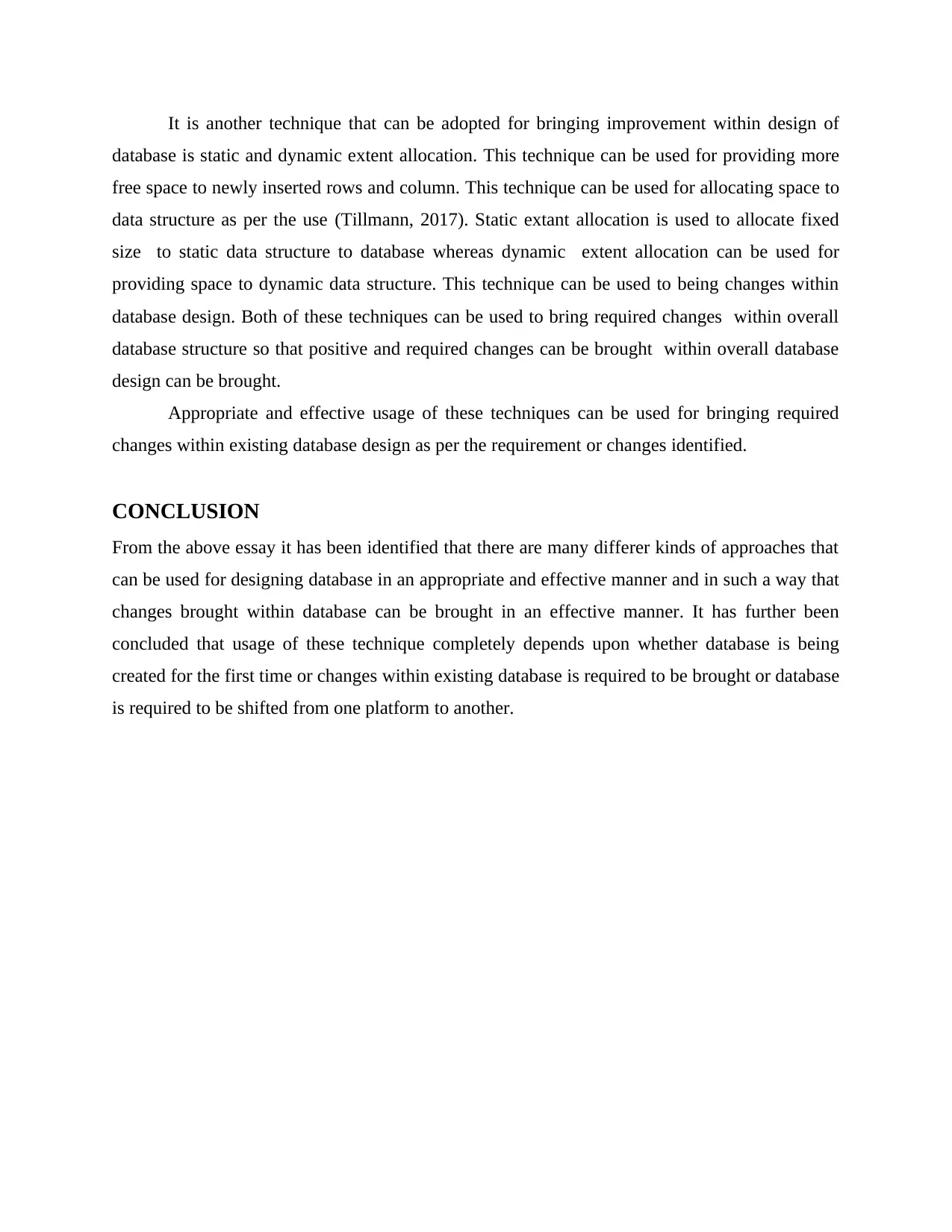A Comprehensive Analysis of Database Design: Approaches & Techniques
VerifiedAdded on 2023/06/16
|7
|1945
|299
Essay
AI Summary
This essay provides a comprehensive overview of database design, delving into alternative approaches such as top-down and bottom-up methodologies, highlighting their advantages and disadvantages. It further discusses advanced techniques like logical and physical database design layouts (ER diagrams) and static and dynamic extent allocation, explaining how these techniques improve database design by optimizing performance, ensuring data integrity, and managing data storage efficiently. The essay concludes by emphasizing the importance of selecting appropriate design approaches and techniques based on specific project requirements, whether creating a new database or modifying an existing one. Desklib offers a wealth of resources, including solved assignments and past papers, to support students in mastering database design principles and practices.

DATABASE DESIGN
Paraphrase This Document
Need a fresh take? Get an instant paraphrase of this document with our AI Paraphraser

Table of Contents
INTRODUCTION...........................................................................................................................3
MAIN BODY...................................................................................................................................3
Investigation of alternative approaches of database design.........................................................3
Discussion of advanced techniques of database design and ways in which they improve the
design of database........................................................................................................................4
CONCLUSION................................................................................................................................6
REFERENCES................................................................................................................................1
INTRODUCTION...........................................................................................................................3
MAIN BODY...................................................................................................................................3
Investigation of alternative approaches of database design.........................................................3
Discussion of advanced techniques of database design and ways in which they improve the
design of database........................................................................................................................4
CONCLUSION................................................................................................................................6
REFERENCES................................................................................................................................1

INTRODUCTION
Database design can be defined as a way of organizing data as per the database model
within selected database (Nathan and et. al., 2019). Database design directly helps in identifying
type of data that must be stored, ways in which that data must be stored, elements with which
that data should be interrelated, and ensure that, selected data fits perfectly with the database
model developed. This essay will lay emphasis upon database design, approaches of database
design, advance techniques of database design and ways in which improvement within database
design can be brought in an appropriate manner.
MAIN BODY
Investigation of alternative approaches of database design
Database design is a kind of task of designing overall structure of the database in such a
manner that all the data requirements of the application are easily stored within the database in
an appropriate manner (Hajji, Qbadou and Mansouri, 2019). There are two most commonly used
approaches of database design, both of them are used for designing a database but at different
time and at different time period as well as in different ways. Both the type of approaches are
used in different ways and explanation of both the type of approaches of database design have
been explained below:
Top- down approach:
Top- down approach of database design is mostly used when development of a new
database comes into picture. In this approach extensive planning and research about the database
is done as this research and planning is then further used for development of database. This
approach is most commonly used when development of database for the first time comes into
picture. Not only this, it further helps in provision of high- level view of the database with all the
main requirements of the database can be identified and fulfilled at initial phase itself. Some of
the main advantages of this approach are: it directly helps in providing high level view of all the
main components of database, it further helps in providing complete view of ways in which any
kind of changes can affect entire database (Roy-Hubara and Sturm, 2018). This approach further
helps in identifying ways in which redundancy within database can be reduced and it can be
developed in more coherent manner. Another advantage of this approach is that it can directly
help in specifying all the main requirements of the database without worrying about its
implementation. But as compared to other approaches, it is quite a time- consuming approach
Database design can be defined as a way of organizing data as per the database model
within selected database (Nathan and et. al., 2019). Database design directly helps in identifying
type of data that must be stored, ways in which that data must be stored, elements with which
that data should be interrelated, and ensure that, selected data fits perfectly with the database
model developed. This essay will lay emphasis upon database design, approaches of database
design, advance techniques of database design and ways in which improvement within database
design can be brought in an appropriate manner.
MAIN BODY
Investigation of alternative approaches of database design
Database design is a kind of task of designing overall structure of the database in such a
manner that all the data requirements of the application are easily stored within the database in
an appropriate manner (Hajji, Qbadou and Mansouri, 2019). There are two most commonly used
approaches of database design, both of them are used for designing a database but at different
time and at different time period as well as in different ways. Both the type of approaches are
used in different ways and explanation of both the type of approaches of database design have
been explained below:
Top- down approach:
Top- down approach of database design is mostly used when development of a new
database comes into picture. In this approach extensive planning and research about the database
is done as this research and planning is then further used for development of database. This
approach is most commonly used when development of database for the first time comes into
picture. Not only this, it further helps in provision of high- level view of the database with all the
main requirements of the database can be identified and fulfilled at initial phase itself. Some of
the main advantages of this approach are: it directly helps in providing high level view of all the
main components of database, it further helps in providing complete view of ways in which any
kind of changes can affect entire database (Roy-Hubara and Sturm, 2018). This approach further
helps in identifying ways in which redundancy within database can be reduced and it can be
developed in more coherent manner. Another advantage of this approach is that it can directly
help in specifying all the main requirements of the database without worrying about its
implementation. But as compared to other approaches, it is quite a time- consuming approach
⊘ This is a preview!⊘
Do you want full access?
Subscribe today to unlock all pages.

Trusted by 1+ million students worldwide

and consumes lots of time, not only this, this approach requires lots of time consumption
between designer and end users of the database. This approach is used for database designing
when a general idea of system to be developed is required to be gained so that things that are
required to be asked from the end user can be identified in an appropriate manner. Mostly this
approach is used when detailed understanding of system required to be developed is required to
be gained by designer or database developer so that even if anything important is missed then it
can be identified in a timely and appropriate manner.
Bottom- up approach:
Bottom- up approach is mostly used by database designers when they need to migrate
database from one physical database to another database. This approach starts with a particular
point of interest and then climbs at higher level view and then later down to the line. In this,
designers check all the interfaces that database has for identifying what kind of information is
stored within database and ways in which it is stored (Zdepski, Bini and Matos, 2020). This
approach is also used when some important changes are required to be brought within database
and new relationship is required to be developed or some sort of adjustments are required to be
brought within existing schemas. Some of the main advantages of this approach are: this
approach can easily get something quick to get in operations. Not only this it can further help in
getting critical modules designed and implemented as soon as possible. But it also has a
disadvantage i.e., it cannot help in providing high level view of database and ways in which any
kind of change can affect a database (Lee, Wei and Mukhiya, 2018). Not only this, it further
requires more time as first of all requirements of the database and end users are required to be
identified first of all and then those requirements are required to be mapped with changes
required to be made to database.
Discussion of advanced techniques of database design and ways in which they improve the
design of database
There are many different kinds of advance techniques that can be used for database
designing. Each of these techniques can be used for bringing improvement within overall design
of the database. These advance techniques can be used for designing a database in more specific
and appropriate manner. Not only this, adoption of these advance techniques can further help in
designing a database in an appropriate and accurate manner.
Logical and physical database design layout (ER diagram)
between designer and end users of the database. This approach is used for database designing
when a general idea of system to be developed is required to be gained so that things that are
required to be asked from the end user can be identified in an appropriate manner. Mostly this
approach is used when detailed understanding of system required to be developed is required to
be gained by designer or database developer so that even if anything important is missed then it
can be identified in a timely and appropriate manner.
Bottom- up approach:
Bottom- up approach is mostly used by database designers when they need to migrate
database from one physical database to another database. This approach starts with a particular
point of interest and then climbs at higher level view and then later down to the line. In this,
designers check all the interfaces that database has for identifying what kind of information is
stored within database and ways in which it is stored (Zdepski, Bini and Matos, 2020). This
approach is also used when some important changes are required to be brought within database
and new relationship is required to be developed or some sort of adjustments are required to be
brought within existing schemas. Some of the main advantages of this approach are: this
approach can easily get something quick to get in operations. Not only this it can further help in
getting critical modules designed and implemented as soon as possible. But it also has a
disadvantage i.e., it cannot help in providing high level view of database and ways in which any
kind of change can affect a database (Lee, Wei and Mukhiya, 2018). Not only this, it further
requires more time as first of all requirements of the database and end users are required to be
identified first of all and then those requirements are required to be mapped with changes
required to be made to database.
Discussion of advanced techniques of database design and ways in which they improve the
design of database
There are many different kinds of advance techniques that can be used for database
designing. Each of these techniques can be used for bringing improvement within overall design
of the database. These advance techniques can be used for designing a database in more specific
and appropriate manner. Not only this, adoption of these advance techniques can further help in
designing a database in an appropriate and accurate manner.
Logical and physical database design layout (ER diagram)
Paraphrase This Document
Need a fresh take? Get an instant paraphrase of this document with our AI Paraphraser

Entity relationship digram is a kind of graphical representation of or a approach that can
be used for designing a database (Imam and et. al., 2019). It is a kind of high level data model
that can directly help in defining main data elements and relationship between all the main
elements of database in an appropriate and specified manner. In this diagram entity is one of the
main objects in database that can directly help in distinguishing between real world objectives
and surrounding environment objects. Entity has its own set of properties and each properties has
its own set of values. Each of these entities has its own attributes that helps in explaining main
properties of entity. In other words ER diagram can directivity help in providing overall view of
database and type of data that would be saved within database.
There are two types of entity relationship diagrams or view that can be used as an
advance technique for designing database. First is logical database layout and second is physical
database layout. Physical database layout directly helps in optimizing overall performance and
can also help in ensuring data integrity (Tillmann, 2017). Not only this, physical view of layout
of database can directly help in avoiding unnecessary data redundancies. In this, physical
database design layout first of all, all the entities are transformed into tables, attributes are used
for transforming into columns of table all the attributes are then transformed into rows of the
database. This physical database design layout can directly help in bringing improvement within
database design as using this layout a clear clarity about the database can be provided and can
make it much easier for designer to understand to understand changes that are required to be
brought within database of ways in which data within this database is stored.
Whereas, logical database design layout is another technique of transforming conceptual
schema of database into data model schema. It can directly help in understanding and arranging
data into series and logical order (Tillmann, 2017). This layout can also be considered as an
appropriate technique that can be used for understanding ways ion which data is stored in non-
redundant manner. This technique can be used to understand current or existing database design
in an appropriate manner so that if any kind of changes that are required to be brought can be
done and impact upon database can be reduced. It can also be said that database design can be
improved and any kind of changed that are required to be brought and ways in which database
will be changed can also be identified.
Static and dynamic extent allocation
be used for designing a database (Imam and et. al., 2019). It is a kind of high level data model
that can directly help in defining main data elements and relationship between all the main
elements of database in an appropriate and specified manner. In this diagram entity is one of the
main objects in database that can directly help in distinguishing between real world objectives
and surrounding environment objects. Entity has its own set of properties and each properties has
its own set of values. Each of these entities has its own attributes that helps in explaining main
properties of entity. In other words ER diagram can directivity help in providing overall view of
database and type of data that would be saved within database.
There are two types of entity relationship diagrams or view that can be used as an
advance technique for designing database. First is logical database layout and second is physical
database layout. Physical database layout directly helps in optimizing overall performance and
can also help in ensuring data integrity (Tillmann, 2017). Not only this, physical view of layout
of database can directly help in avoiding unnecessary data redundancies. In this, physical
database design layout first of all, all the entities are transformed into tables, attributes are used
for transforming into columns of table all the attributes are then transformed into rows of the
database. This physical database design layout can directly help in bringing improvement within
database design as using this layout a clear clarity about the database can be provided and can
make it much easier for designer to understand to understand changes that are required to be
brought within database of ways in which data within this database is stored.
Whereas, logical database design layout is another technique of transforming conceptual
schema of database into data model schema. It can directly help in understanding and arranging
data into series and logical order (Tillmann, 2017). This layout can also be considered as an
appropriate technique that can be used for understanding ways ion which data is stored in non-
redundant manner. This technique can be used to understand current or existing database design
in an appropriate manner so that if any kind of changes that are required to be brought can be
done and impact upon database can be reduced. It can also be said that database design can be
improved and any kind of changed that are required to be brought and ways in which database
will be changed can also be identified.
Static and dynamic extent allocation

It is another technique that can be adopted for bringing improvement within design of
database is static and dynamic extent allocation. This technique can be used for providing more
free space to newly inserted rows and column. This technique can be used for allocating space to
data structure as per the use (Tillmann, 2017). Static extant allocation is used to allocate fixed
size to static data structure to database whereas dynamic extent allocation can be used for
providing space to dynamic data structure. This technique can be used to being changes within
database design. Both of these techniques can be used to bring required changes within overall
database structure so that positive and required changes can be brought within overall database
design can be brought.
Appropriate and effective usage of these techniques can be used for bringing required
changes within existing database design as per the requirement or changes identified.
CONCLUSION
From the above essay it has been identified that there are many differer kinds of approaches that
can be used for designing database in an appropriate and effective manner and in such a way that
changes brought within database can be brought in an effective manner. It has further been
concluded that usage of these technique completely depends upon whether database is being
created for the first time or changes within existing database is required to be brought or database
is required to be shifted from one platform to another.
database is static and dynamic extent allocation. This technique can be used for providing more
free space to newly inserted rows and column. This technique can be used for allocating space to
data structure as per the use (Tillmann, 2017). Static extant allocation is used to allocate fixed
size to static data structure to database whereas dynamic extent allocation can be used for
providing space to dynamic data structure. This technique can be used to being changes within
database design. Both of these techniques can be used to bring required changes within overall
database structure so that positive and required changes can be brought within overall database
design can be brought.
Appropriate and effective usage of these techniques can be used for bringing required
changes within existing database design as per the requirement or changes identified.
CONCLUSION
From the above essay it has been identified that there are many differer kinds of approaches that
can be used for designing database in an appropriate and effective manner and in such a way that
changes brought within database can be brought in an effective manner. It has further been
concluded that usage of these technique completely depends upon whether database is being
created for the first time or changes within existing database is required to be brought or database
is required to be shifted from one platform to another.
⊘ This is a preview!⊘
Do you want full access?
Subscribe today to unlock all pages.

Trusted by 1+ million students worldwide

REFERENCES
Books and journals
Hajji, M., Qbadou, M. and Mansouri, K., 2019. Onto2DB: towards an eclipse plugin for
automated database design from an ontology. International Journal of Electrical &
Computer Engineering (2088-8708), 9(4).
Imam, A.A., and et. al., 2019, April. Literature Review on Database Design Testing Techniques.
In Computer Science On-line Conference (pp. 1-13). Springer, Cham.\
Lee, J., Wei, T. and Mukhiya, S.K., 2018. Hands-On Big Data Modeling: Effective database
design techniques for data architects and business intelligence professionals. Packt
Publishing Ltd.
Nathan, S., and et. al., 2019. Blockchain meets database: Design and implementation of a
blockchain relational database. arXiv preprint arXiv:1903.01919.
Roy-Hubara, N. and Sturm, A., 2018. Exploring the Design Needs for the New Database Era.
In Enterprise, Business-Process and Information Systems Modeling (pp. 276-290).
Springer, Cham.
Tillmann, G., 2017. Introduction to Usage-Driven Database Design. In Usage-Driven Database
Design (pp. 3-12). Apress, Berkeley, CA.
Zdepski, C., Bini, T.A. and Matos, S.N., 2020. New Perspectives for NoSQL Database Design:
A Systematic Review. American Scientific Research Journal for Engineering,
Technology, and Sciences (ASRJETS), 68(1), pp.50-62.
1
Books and journals
Hajji, M., Qbadou, M. and Mansouri, K., 2019. Onto2DB: towards an eclipse plugin for
automated database design from an ontology. International Journal of Electrical &
Computer Engineering (2088-8708), 9(4).
Imam, A.A., and et. al., 2019, April. Literature Review on Database Design Testing Techniques.
In Computer Science On-line Conference (pp. 1-13). Springer, Cham.\
Lee, J., Wei, T. and Mukhiya, S.K., 2018. Hands-On Big Data Modeling: Effective database
design techniques for data architects and business intelligence professionals. Packt
Publishing Ltd.
Nathan, S., and et. al., 2019. Blockchain meets database: Design and implementation of a
blockchain relational database. arXiv preprint arXiv:1903.01919.
Roy-Hubara, N. and Sturm, A., 2018. Exploring the Design Needs for the New Database Era.
In Enterprise, Business-Process and Information Systems Modeling (pp. 276-290).
Springer, Cham.
Tillmann, G., 2017. Introduction to Usage-Driven Database Design. In Usage-Driven Database
Design (pp. 3-12). Apress, Berkeley, CA.
Zdepski, C., Bini, T.A. and Matos, S.N., 2020. New Perspectives for NoSQL Database Design:
A Systematic Review. American Scientific Research Journal for Engineering,
Technology, and Sciences (ASRJETS), 68(1), pp.50-62.
1
1 out of 7
Related Documents
Your All-in-One AI-Powered Toolkit for Academic Success.
+13062052269
info@desklib.com
Available 24*7 on WhatsApp / Email
![[object Object]](/_next/static/media/star-bottom.7253800d.svg)
Unlock your academic potential
Copyright © 2020–2025 A2Z Services. All Rights Reserved. Developed and managed by ZUCOL.





